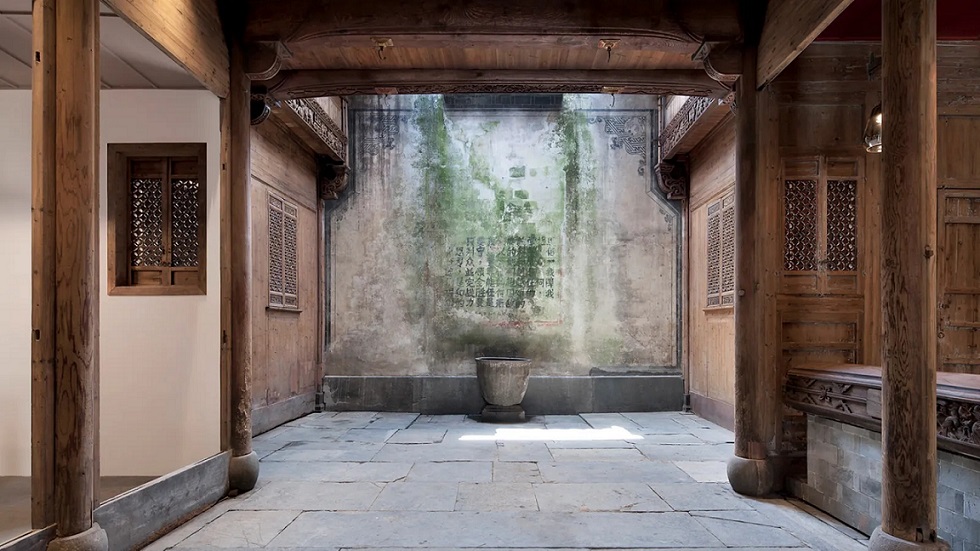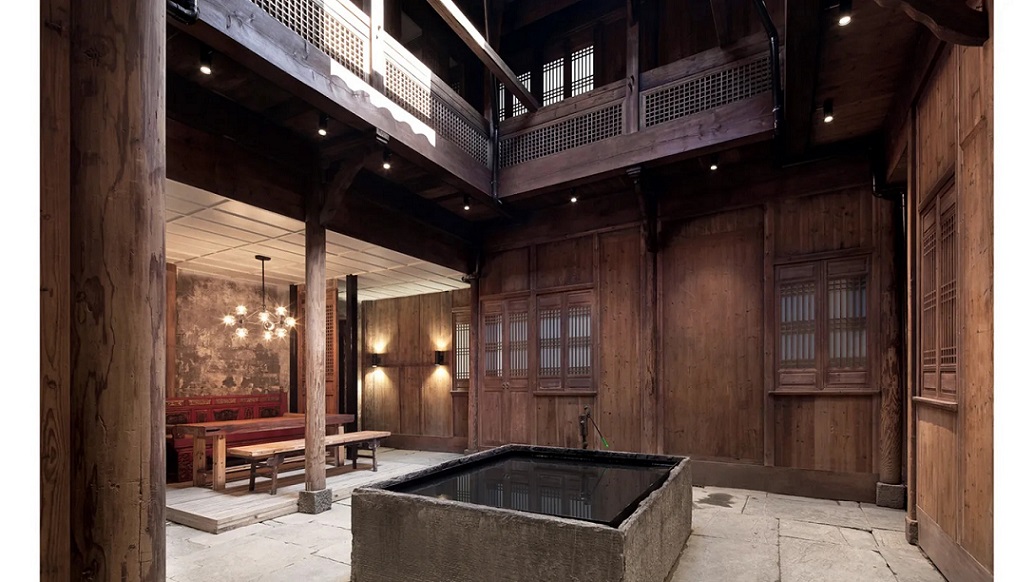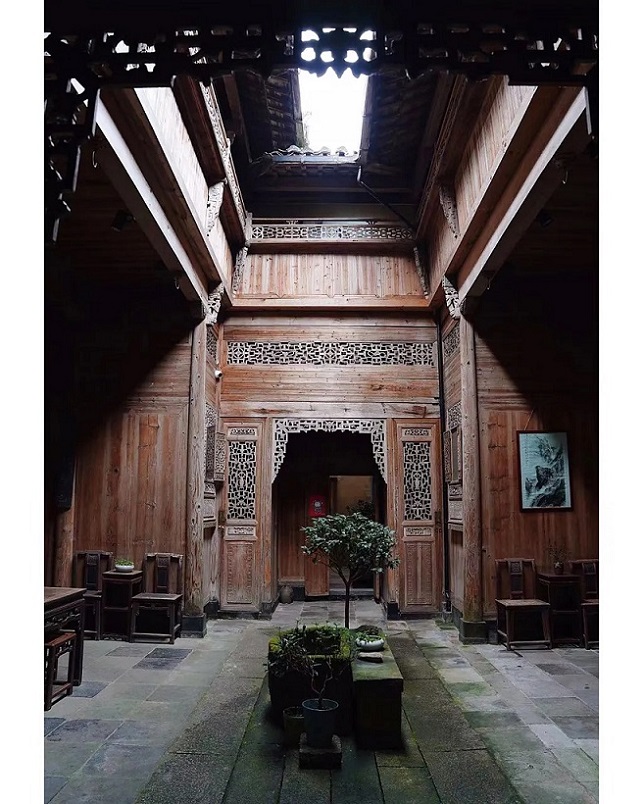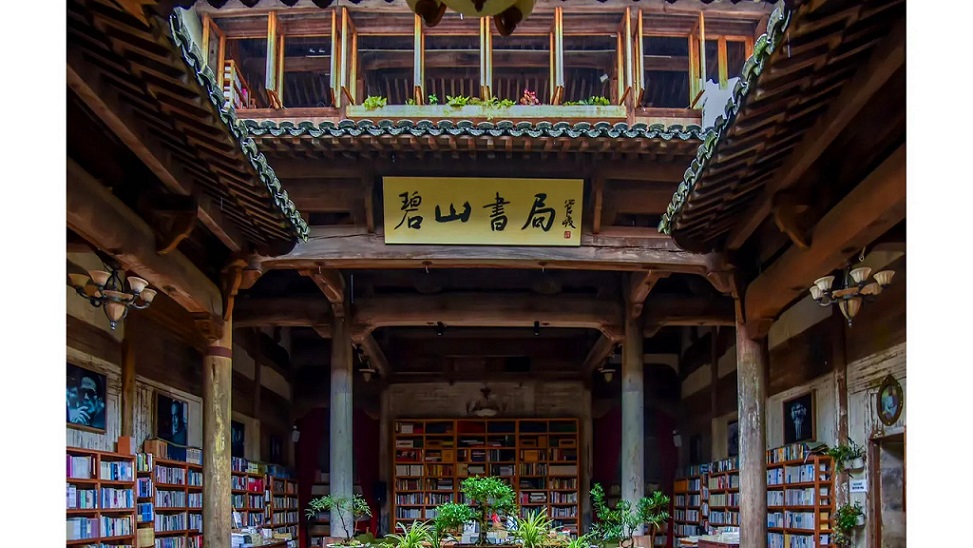 中国古建筑的绿色智慧:古代“天井”如何让中国住宅保持凉爽
中国古建筑的绿色智慧:古代“天井”如何让中国住宅保持凉爽
How ancient ''skywells'' are keeping Chinese homes cool
译文简介
在空调出现之前的时代,中国南方的天井在保持民居凉爽方面发挥了关键作用,如今它们还能继续发挥作用吗?
正文翻译

In the eras before air-conditioning, southern China''s skywells played a key role in keeping people''s homes cool. Could they do it again today?
在空调出现之前的时代,中国南方的天井在保持民居凉爽方面发挥了关键作用,如今它们还能继续发挥作用吗?
Ru Ling loves spending time in skywells. To her, these courtyards of old Chinese houses are the perfect place to be in on a hot and humid day.
茹玲喜欢待在天井里。对她来说,这些中国老宅的天井是湿热天气里的最佳去处。
茹玲喜欢待在天井里。对她来说,这些中国老宅的天井是湿热天气里的最佳去处。
"They are airy, cool and well-shaded," says 40-year-old Ru.
“这里通风、凉爽、遮阳”,40 岁的茹女士说道。
“这里通风、凉爽、遮阳”,40 岁的茹女士说道。
From 2014 to 2021, Ru lived in a century-old timber-frxd home in the village of Guanlu in eastern China's Anhui province. She moved there for a change of life after living and working in air-conditioned buildings for many years.
2014年至2021年,茹女士住在中国东部安徽省关麓村一栋有着百年历史的木结构房屋里。在空调建筑里生活和工作多年后,她为了改变生活而搬到那里。
2014年至2021年,茹女士住在中国东部安徽省关麓村一栋有着百年历史的木结构房屋里。在空调建筑里生活和工作多年后,她为了改变生活而搬到那里。
"The natural cool feeling of my home in summer was so refreshing, and a rare find in the modern world," she says. "It also gave the house a calming and zen vibe."
“夏天,家里自然凉爽的感觉让人神清气爽,这是现代世界罕见的”,她说道。“天井也给房屋带来了平静和禅意”。
“夏天,家里自然凉爽的感觉让人神清气爽,这是现代世界罕见的”,她说道。“天井也给房屋带来了平静和禅意”。
Ru says that the house's skywell helped create this cooling effect. And she's not alone in extolling the benefits of skywells in hot weather. Studies have found that the temperatures inside some of the skywells in southern China are significantly lower than the outside – by up to 4.3C.
茹女士说,房屋的天井有助于产生这样的降温效果。在炎热的天气里称赞天井益处的不止她一个人。研究发现,中国南方一些天井内部的温度明显低于室外,最高可达4.3℃。
茹女士说,房屋的天井有助于产生这样的降温效果。在炎热的天气里称赞天井益处的不止她一个人。研究发现,中国南方一些天井内部的温度明显低于室外,最高可达4.3℃。
In today's rapidly urbanising China, fewer and fewer people live in skywell dwellings – air-conditioned flats in multi-storeyed buildings and tower blocks are the main forms of homes.
在当今快速城市化的中国,居住天井民居的人越来越少——多层建筑和塔楼中的空调公寓是住宅的主要形式。
在当今快速城市化的中国,居住天井民居的人越来越少——多层建筑和塔楼中的空调公寓是住宅的主要形式。
But a revival of interest in traditional Chinese architecture is leading some of historic buildings with skywells to be restored for modern times. Meanwhile, as a government push has made low-carbon innovations in the building sector a trend in the country, some architects are drawing inspiration from skywells and other traditional Chinese architectural features to help keep new buildings cooler.
但随着人们对中国传统建筑的兴趣重新燃起,一些天井式古建筑正在被修缮,以适应现代的需要。与此同时,随着政府推动低碳创新成为中国建筑行业的趋势,一些建筑师正在从天井及其他中国传统建筑特色中汲取灵感,以帮助新建建筑保持凉爽。
但随着人们对中国传统建筑的兴趣重新燃起,一些天井式古建筑正在被修缮,以适应现代的需要。与此同时,随着政府推动低碳创新成为中国建筑行业的趋势,一些建筑师正在从天井及其他中国传统建筑特色中汲取灵感,以帮助新建建筑保持凉爽。

In a bid to help keep modern buildings cool, architects are drawing inspiration from skywells
为了有助于现代建筑保持凉爽,建筑师正在从天井中汲取灵感。
A skywell, or "tian jing" in Mandarin, is a typical feature of a traditional home in southern and eastern China. Different from a northern Chinese courtyard, or "yuan zi", a skywell is smaller and less exposed to the outdoor environment.
天井是中国南部和东部传统民居的典型特征。与中国北方的庭院不同,天井较小,与户外环境接触较少。
天井是中国南部和东部传统民居的典型特征。与中国北方的庭院不同,天井较小,与户外环境接触较少。
They are commonly seen in homes dating to Ming (1368-1644) and Qing (1644-1911) dynasties, which were designed to house different generations of relatives, according to a 2010 paper published by the Journal of Nanchang University in China.
根据中国南昌大学学报2010 年发表的一篇论文,天井常见于明朝 (1368-1644) 和清朝 (1644-1911) 时期的民居众,这些民居是为多代同堂而设计的。
根据中国南昌大学学报2010 年发表的一篇论文,天井常见于明朝 (1368-1644) 和清朝 (1644-1911) 时期的民居众,这些民居是为多代同堂而设计的。
Although a skywell's size and design vary from region to region, it is almost always rectangular and located in the core of a house. It is either enclosed by rooms on four sides or three sides plus a wall. Some large houses have more than one skywell.
尽管天井的大小和设计因地而异,但形状几乎都是矩形的,并且位于房子的中心位置。天井要么四面有房屋,要么三面有房屋一面有围墙。一些大宅有多个天井。
尽管天井的大小和设计因地而异,但形状几乎都是矩形的,并且位于房子的中心位置。天井要么四面有房屋,要么三面有房屋一面有围墙。一些大宅有多个天井。
They are relatively common in historic residences in large swathes of southern and eastern China, such as Sichuan, Jiangsu, Anhui and Jiangxi. Some of the best-preserved can be found in Huizhou, a historical region that spreads between modern-day Anhui and Jiangxi.
天井在中国南部和东部大片地区(如四川、江苏、安徽和江西)的古代民居中比较常见。一些保存最完好的天井位于古徽州(位于现今安徽和江西之间的地区)。
天井在中国南部和东部大片地区(如四川、江苏、安徽和江西)的古代民居中比较常见。一些保存最完好的天井位于古徽州(位于现今安徽和江西之间的地区)。
Skywells were designed to cool buildings in an era well before air-conditioning existed. When wind blows above a skywell house, it can enter the indoor space through the opening. Because outdoor air is often cooler than indoor air, the incoming breeze travels down the walls to the lower stories and create airflows by replacing warmer indoor air, which rises and leaves through the opening.
天井的设计目的是在空调出现之前为建筑物降温。当风吹过天井房屋的上方时,会通过天井口吹入室内。由于室外空气通常比室内空气凉爽,因此吹进来的微风会沿着墙壁下沉到房屋低处,与室内的热空气交换而产生气流,而热空气上升并从天井口排出。
原创翻译:龙腾网 http://www.ltaaa.cn 转载请注明出处
天井的设计目的是在空调出现之前为建筑物降温。当风吹过天井房屋的上方时,会通过天井口吹入室内。由于室外空气通常比室内空气凉爽,因此吹进来的微风会沿着墙壁下沉到房屋低处,与室内的热空气交换而产生气流,而热空气上升并从天井口排出。
原创翻译:龙腾网 http://www.ltaaa.cn 转载请注明出处
Yu Youhong, 55, has spent more than 30 years restoring skywell homes in Wuyuan county of Jiangxi province, a part of the old Huizhou. As an inheritor of intangible cultural heritage recognised by China's Ministry of Culture and Tourism, he has obtained a wealth of knowledge about skywells.
55岁的俞友鸿花了30多年的时间修缮江西省婺源县(古属徽州)的天井民居。作为中国文化和旅游部认定的非物质文化遗产传承人,他获得了大量关于天井的知识。
55岁的俞友鸿花了30多年的时间修缮江西省婺源县(古属徽州)的天井民居。作为中国文化和旅游部认定的非物质文化遗产传承人,他获得了大量关于天井的知识。
The main purposes of a skywell, he says, is to allow in light, improve ventilation and harvest rainwater. In Huizhou, a skywell is small but tall, and the rooms around it can block out sunlight on hot days, enabling the bottom of the skywell to stay cool, he adds.
他说,天井的主要目的是让光线进入、改善通风、收集雨水。他补充说在惠州,天井虽小但很高,天井四周的房屋可以在热天遮挡阳光,使天井底部保持凉爽。
他说,天井的主要目的是让光线进入、改善通风、收集雨水。他补充说在惠州,天井虽小但很高,天井四周的房屋可以在热天遮挡阳光,使天井底部保持凉爽。
Meanwhile, hot air inside the house can rise and escape through the opening above the skywell, which "works just like a chimney".
与此同时,房屋内的热空气上升并从天井口排出,“其原理类似于烟囱”。
与此同时,房屋内的热空气上升并从天井口排出,“其原理类似于烟囱”。
"The ground floor of old Huizhou houses normally have very high ceilings and face towards the skywell directly, which is good for ventilation," Yu says. "Some wealthy families had two or even three skywells, enabling them to have even better ventilation."
“古徽州民居的第一层楼通常有很高的屋顶,并且正对着天井,这有利于通风”,俞先生说道。“有的富裕人家有两三个天井,通风效果更好”。
“古徽州民居的第一层楼通常有很高的屋顶,并且正对着天井,这有利于通风”,俞先生说道。“有的富裕人家有两三个天井,通风效果更好”。

Hot air inside the house rises up and escapes through the skywell opening, which acts like a chimney
房屋内的热空气上升并从天井口排出,其原理类似于烟囱。
Although skywell buildings have existed in China for hundreds of years, in recent times they have often been forgotten by people who prefer modern facilities. Over the past two decades, however, due to a revival of traditional Chinese architecture, part of a broader resurgence of traditional Chinese culture, skywell buildings have been making a comeback.
尽管天井建筑在中国已经存在了数百年,但近年来通常被喜欢现代化设施的人们所遗忘。但在过去的二十年里,由于中国传统建筑的复兴,作为中国传统文化全面复兴的一部分,天井建筑已经卷土重来。
原创翻译:龙腾网 http://www.ltaaa.cn 转载请注明出处
尽管天井建筑在中国已经存在了数百年,但近年来通常被喜欢现代化设施的人们所遗忘。但在过去的二十年里,由于中国传统建筑的复兴,作为中国传统文化全面复兴的一部分,天井建筑已经卷土重来。
原创翻译:龙腾网 http://www.ltaaa.cn 转载请注明出处
One of the skywell homes restored by Yu is in the village of Yan, in Wuyuan county. The once-derelict 300-year-old house was bought by Edward Gawne, a former marketing director from the UK, and his Chinese wife, Liao Minxin, in 2015. The couple turned the three-storey house into a 14-room boutique hotel with the help of Yu.
俞先生修缮的一处天井民居位于婺源县延村。这栋有着300年历史的破旧民居被来自英国的前营销总监爱德华·高恩和他的中国妻子廖敏欣于2015年买下。在俞先生的帮助下,这对夫妇将这栋三层楼的民居变成了一家拥有14间客房的精品酒店。
俞先生修缮的一处天井民居位于婺源县延村。这栋有着300年历史的破旧民居被来自英国的前营销总监爱德华·高恩和他的中国妻子廖敏欣于2015年买下。在俞先生的帮助下,这对夫妇将这栋三层楼的民居变成了一家拥有14间客房的精品酒店。
Although Gawne and Liao had air-conditioning fitted in all their guestrooms, they kept the communal spaces surrounding the skywells in their original status: unsealed and with natural airflow. Gawne says that even without air conditioning the skywell areas are very comfortable in summer. "Everyone notes when they step into the house how naturally cool it is."
尽管高恩和廖女士给所有的客房都安装了空调,但他们让天井周围的公共空间保持原状:没有封闭,自然通风。加恩说,即使没有空调,天井区域在夏天也会让人非常舒服。“每个人走进房子时都会注意到,这里是多么的自然凉爽”。
尽管高恩和廖女士给所有的客房都安装了空调,但他们让天井周围的公共空间保持原状:没有封闭,自然通风。加恩说,即使没有空调,天井区域在夏天也会让人非常舒服。“每个人走进房子时都会注意到,这里是多么的自然凉爽”。
Yu says he expects skywells, as an architectural feature, to be "more and more popular" among younger generations because of their ventilation and lighting functions, especially as sustainability becomes an important element for new buildings.
俞先生说,他希望天井作为一种建筑特色,由于通风和采光功能而越来越受到年轻人的青睐,尤其是现在可持续发展已成为新建筑的重要元素。
俞先生说,他希望天井作为一种建筑特色,由于通风和采光功能而越来越受到年轻人的青睐,尤其是现在可持续发展已成为新建筑的重要元素。
Even when there is no natural wind, air circulation still takes place inside a skywell home due to the "chimney effect". The temperature difference between the top and bottom of the skywell means warm air inside the skywell rises, drawing cooler air from the rooms to the bottom of the skywell.
即使没有自然风,由于“烟囱效应”,天井民居内仍然能实现空气流通。天井顶部和底部之间的温差意味着天井内的热空气上升,将房间中的冷空气吸入天井底部。
即使没有自然风,由于“烟囱效应”,天井民居内仍然能实现空气流通。天井顶部和底部之间的温差意味着天井内的热空气上升,将房间中的冷空气吸入天井底部。
Traditional skywell homes further south in Lingnan, a historical region consisting of the modern-day Chinese provinces of Guangxi, Guangdong and Hainan and what is now northern and central Vietnam, have smaller and deeper skywells than other areas due to the longer and hotter summers.
在更南端的古代岭南地区(由现今的广西、广东、海南、今越南北部和中部组成),由于夏季更热更长,传统的天井民居与其他地区相比有更小、更深的天井。
在更南端的古代岭南地区(由现今的广西、广东、海南、今越南北部和中部组成),由于夏季更热更长,传统的天井民居与其他地区相比有更小、更深的天井。
As a transition space between indoor life and the outdoor environment, a skywell acts as an effective heat buffer to shield residents from the hot air outside. But the largest part of skywell's cooling effect actually comes when there are bodies of water in the enclosure.
作为室内生活和室外环境之间的过渡空间,天井有降温的作用,为居民遮挡室外的热空气,但其实天井最大的降温效果是在天井内有水体的时候。
作为室内生活和室外环境之间的过渡空间,天井有降温的作用,为居民遮挡室外的热空气,但其实天井最大的降温效果是在天井内有水体的时候。
Evaporated water cools hot air, a process known as evaporative cooling which is well-reflected in Huizhou skywells. In the past, Huizhou families collected rainwater in their skywells because they believed such an action could safeguard and boost their wealth.
水蒸发冷却热空气,这一过程被称为蒸发冷却,在徽州的天井中得到了很好的体现。过去,徽州家庭在天井中收集雨水,因为他们相信这样做可以保护和增加他们的财富。
水蒸发冷却热空气,这一过程被称为蒸发冷却,在徽州的天井中得到了很好的体现。过去,徽州家庭在天井中收集雨水,因为他们相信这样做可以保护和增加他们的财富。
Skywells here therefore have channels around them to drain rainwater coming from the roofs. According to Yu, some wealthy families had a drainage system dug under the skywell to ensure that rainwater would only leave the house after circumnavigating the front hall under the ground.
因此,徽州天井的周围设置了排水渠,用于排出来自屋顶的雨水。据俞先生介绍,一些富裕的家庭在天井下挖了排水系统,以确保雨水在地下绕过前厅后才流出房屋。
因此,徽州天井的周围设置了排水渠,用于排出来自屋顶的雨水。据俞先生介绍,一些富裕的家庭在天井下挖了排水系统,以确保雨水在地下绕过前厅后才流出房屋。
Huizhou skywells also have a large stone vat in the middle to hold water for daily use and to put out fires.
徽州天井的中间还有一个储水的大石缸,以供日常使用和灭火。
徽州天井的中间还有一个储水的大石缸,以供日常使用和灭火。
A 2021 study of skywell dwellings in two traditional Huizhou villages found that evaporative cooling was likely the main reason that average temperatures inside the skywells were 2.6-4.3C lower than the average external temperatures.
2021年对两个徽州传统村庄的天井民居进行的一项研究发现,蒸发冷却效应可能是天井内的平均温度比外部平均温度低2.6-4.3℃的主要原因。
2021年对两个徽州传统村庄的天井民居进行的一项研究发现,蒸发冷却效应可能是天井内的平均温度比外部平均温度低2.6-4.3℃的主要原因。

Skywells act as a heat buffer, shielding residents from hot outside air
天井有降温的作用,为居民遮挡室外的热空气。
原创翻译:龙腾网 http://www.ltaaa.cn 转载请注明出处
Today, government directives are starting to play a key role in the return of skywells in modern buildings. Since 2013, the Chinese central government has been pushing for green buildings which save resources and emit less pollution in their entire lifecycles. A 2019 government instruction required that 70% of buildings completed in 2022 should meet its "green" standard, which includes a series of specific criteria, including how good a building's insulation is and how environmentally-friendly the building materials are.
如今,政府指令开始对现代建筑中天井的回归发挥关键作用。自2013年以来,中国中央政府一直在推动绿色建筑的发展,绿色建筑在全生命周期中节约资源、减少污染排放。2019年的一项政府指令要求,2022年建成的70%的建筑应达到“绿色”标准,其中包括一系列具体标准,包括建筑的隔热效果、建筑材料的环保等级等。
如今,政府指令开始对现代建筑中天井的回归发挥关键作用。自2013年以来,中国中央政府一直在推动绿色建筑的发展,绿色建筑在全生命周期中节约资源、减少污染排放。2019年的一项政府指令要求,2022年建成的70%的建筑应达到“绿色”标准,其中包括一系列具体标准,包括建筑的隔热效果、建筑材料的环保等级等。
Architects are now looking towards the principles behind skywells while designing new buildings to save energy. One example is the National Heavy Vehicle Engineering Technology Research Centre in the eastern Chinese city of Jinan. The 18-storey glass-walled tower block, completed last year, has a giant interior skywell in the middle, which stretches from the fifth to the top floor. The elevators, toilets and meeting rooms are all situated around this shaft, which helps improve the lighting and ventilation of the centre and reduces the overall energy consumption, the architects, from the Shanghai-based CCDI Group say.
目前,建筑师们在设计新建筑的同时也在关注天井背后的原理,以节约能源。坐落在中国东部济南市的“国家重型汽车工程技术研究中心”就是一个例子。这座18层高的玻璃幕墙塔楼于去年竣工,中间有一个巨大的室内天井,从五层一直延伸到顶层。总部设在上海的悉地国际集团的建筑师表示,电梯、卫生间、会议室都位于天井周围,这有助于改善中心区域的照明和通风,并降低总体能耗。
目前,建筑师们在设计新建筑的同时也在关注天井背后的原理,以节约能源。坐落在中国东部济南市的“国家重型汽车工程技术研究中心”就是一个例子。这座18层高的玻璃幕墙塔楼于去年竣工,中间有一个巨大的室内天井,从五层一直延伸到顶层。总部设在上海的悉地国际集团的建筑师表示,电梯、卫生间、会议室都位于天井周围,这有助于改善中心区域的照明和通风,并降低总体能耗。
In the county of Jixi in Xuancheng, a part of historic Huizhou, the site of the former town hall was revamped in 2013 to be a museum. The complex pays homage to its surroundings of Huizhou-style architectures by having several skywells, which it says brings airflow to the inside and helps to preserve several ancient trees on the site.
位于古徽州的宣城市绩溪县,原市政厅旧址于 2013 年改建为博物馆。该建筑群设有多个天井,以此向周围的徽州风格建筑致敬,据说这些天井将气流导入建筑内,并有助于保护现场的几棵古树。
位于古徽州的宣城市绩溪县,原市政厅旧址于 2013 年改建为博物馆。该建筑群设有多个天井,以此向周围的徽州风格建筑致敬,据说这些天井将气流导入建筑内,并有助于保护现场的几棵古树。
Meanwhile, a popular tourist village in Sichuan – a province known for its hot and humid summer – has a series of round houses with skywells and large eaves.
与此同时,在以夏天湿热而著称的四川省,一个受欢迎的旅游村有许多带有天井和大屋檐的圆形房屋。
与此同时,在以夏天湿热而著称的四川省,一个受欢迎的旅游村有许多带有天井和大屋檐的圆形房屋。
Some skyscrapers use the ventilation principle of skywells to improve airflows without building a courtyard out of concerns of practicality. The 68-storey Dongguan TBA Tower in Guandong province, for example, brings natural airflows to every floor with internal "windpipes" that function in a similar way to skywells. The tower's general manager told a local newspaper that the aim is to keep the building’s temperature comfortable in spring and autumn, using only natural ventilation.
有些摩天大楼出于实用性的考虑,利用天井的通风原理来改善气流,而不建造庭院。例如,广东省 68 层高的东莞台商大厦通过内部“气管”将自然气流导入每个楼层,其功能与天井类似。大厦的总经理向当地一家报纸透露,其目的是仅利用自然通风,使建筑在春季和秋季保持舒适的温度。
有些摩天大楼出于实用性的考虑,利用天井的通风原理来改善气流,而不建造庭院。例如,广东省 68 层高的东莞台商大厦通过内部“气管”将自然气流导入每个楼层,其功能与天井类似。大厦的总经理向当地一家报纸透露,其目的是仅利用自然通风,使建筑在春季和秋季保持舒适的温度。

The National Heavy Vehicle Engineering Technology Research Centre in the eastern Chinese city of Jinan features a giant skywell
坐落在中国东部济南市的“国家重型汽车工程技术研究中心”有一个巨大的天井。
原创翻译:龙腾网 http://www.ltaaa.cn 转载请注明出处
Ancient "green wisdom" such as skywells continue to inspire today's climate adaptive design and innovations in passive cooling, according to Wang Zhengfeng, a postdoctoral researcher in environmental humanities at the Institute for Area Studies at Leiden University in the Netherlands who previously trained as an architect. Passive cooling is a method that incorporates design and technology to cool a building without the use of power.
荷兰莱顿大学区域研究所的环境人文博士后研究员王正凤曾接受过建筑师培训,她表示,像天井这种古代“绿色智慧”继续启发着当今的气候适应性设计和被动降温方面的创新。被动降温是一种结合设计和技术,在不使用电力的情况下给建筑物降温的方法。
荷兰莱顿大学区域研究所的环境人文博士后研究员王正凤曾接受过建筑师培训,她表示,像天井这种古代“绿色智慧”继续启发着当今的气候适应性设计和被动降温方面的创新。被动降温是一种结合设计和技术,在不使用电力的情况下给建筑物降温的方法。
However, Wang points out some challenges for bringing skywells into modern designs. The mechanisms of courtyards facilitating natural lighting, ventilation and rain collection are well known, but applying these principles needs to be site-specific, she says.
然而,王女士指出了将天井应用于现代设计中的一些挑战。她说,天井改善自然采光、通风、雨水收集的原理众所周知,但运用这些原理需要因地制宜。
原创翻译:龙腾网 http://www.ltaaa.cn 转载请注明出处
然而,王女士指出了将天井应用于现代设计中的一些挑战。她说,天井改善自然采光、通风、雨水收集的原理众所周知,但运用这些原理需要因地制宜。
原创翻译:龙腾网 http://www.ltaaa.cn 转载请注明出处
Because traditional skywells had different shapes, sizes and features, which were highly dependent on their natural surroundings – for example, how much sunlight or rainfall there was in the region – adding skywells into modern buildings requires designers to be sensitive to their project's context and situation, making it difficult to apply them as a universal solution, she explains.
她解释说,由于传统的天井具有不同的形状、大小、功能,这些都高度依赖于自然环境(例如,该地区有多少阳光或降雨量),所以在现代建筑中采用天井需要设计师对项目的环境和地理位置有很强的感知力,很难找到一种通用的解决方案。
她解释说,由于传统的天井具有不同的形状、大小、功能,这些都高度依赖于自然环境(例如,该地区有多少阳光或降雨量),所以在现代建筑中采用天井需要设计师对项目的环境和地理位置有很强的感知力,很难找到一种通用的解决方案。
"Meanwhile, artificial lighting, air conditioning and water supply have become so readily available that we depend on them with little regard for the environmental cost," she adds. "It won't be easy to be sustainable by learning from the past without reflecting on our current behaviours."
“与此同时,人工照明、空调、供水已经变得唾手可得,以至于我们对它们的依赖几乎不考虑环境成本”,她补充道。“借鉴古代的经验而不反思当前的行为,这样是不容易实现可持续发展的”。
“与此同时,人工照明、空调、供水已经变得唾手可得,以至于我们对它们的依赖几乎不考虑环境成本”,她补充道。“借鉴古代的经验而不反思当前的行为,这样是不容易实现可持续发展的”。
When asked about why skywells have caught more attention of modern Chinese people, Wang says that the courtyard is also designed to serve as a gathering space for families or communities, and comes with ritual meanings. "Perhaps changes in the way of life could also trigger vernacular nostalgia among people living in concrete and glass forests."
当被问及为什么天井越来越受到当代中国人的关注时,王女士说,天井的设计目的也是作为家庭或社区的聚会场所,并具有仪式色彩。“对于生活在混凝土和玻璃森林里的人们来说,也许生活方式的改变也触发了他们对民居风格的怀旧之情”。
当被问及为什么天井越来越受到当代中国人的关注时,王女士说,天井的设计目的也是作为家庭或社区的聚会场所,并具有仪式色彩。“对于生活在混凝土和玻璃森林里的人们来说,也许生活方式的改变也触发了他们对民居风格的怀旧之情”。
评论翻译
很赞 ( 7 )
收藏